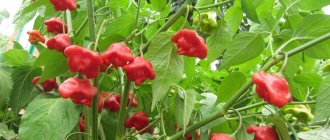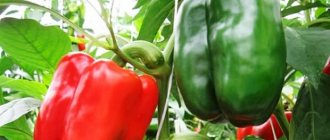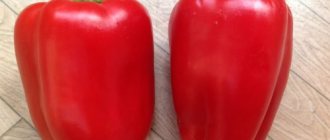The most common and widely used variety of hot pepper is the Red Fatty. Due to the simple care of the plant during cultivation, many gardeners and spicy lovers prefer planting this particular variety in their beds. Photos and descriptions of peppers, the advantages of the variety, features of cultivation in open ground and in a greenhouse - all this information will help new gardeners get acquainted with the “Red Fat Man” variety and grow the piquant fruits themselves.
Description and characteristics of the variety
Red fat pepper is a cold-resistant variety. It grows well in open ground, but can also be grown in greenhouses if the region is very cold. The cultivar tolerates the conditions of the northern regions well.
The bush is of medium height, branched, grows up to 50-60 cm. The variety is late, the fruits reach biological ripeness 130-140 days after germination. You cannot pick them unripe, otherwise the burning substance will not have time to form, and the taste will be inexpressive.
The pepper is drooping, elongated cone-shaped, red in color. The fruits reach 16-19 cm in length and weigh 60-90 g. The walls are of medium thickness, about 4 mm (according to other sources, up to 7 mm). The taste is spicy, burning. You can use it to enrich the taste of home-canned food, various dishes, prepare sauces, dry it for seasonings, and even add small pieces to salads.
Red Fat Peppers have a heat rating of 39,000 SHU on the Scoville scale. This is roughly equivalent to the heat of cayenne pepper.
The fruits contain a lot of vitamin C, carotene and beneficial antioxidants.
Advantages and disadvantages
Pepper wins the attention of gardeners with the following worthy characteristics:
- The variety is well protected from viral diseases.
- The crop yield is not affected by lack of lighting and sharp fluctuations in air temperature.
- Pepper can be cultivated in a greenhouse and open ground.
- The fruits have strong walls, so long-distance transportation of the crop does not involve the risk of damage.
- Vegetables have culinary versatility.
- Taking into account the basic requirements for plant formation, all peppers from a bush are approximately the same size.
The main disadvantage of the hybrid is the need for annual costs for purchasing seeds. The culture is not capable of producing material suitable for subsequent planting.
Landing
Seeds are sown in the second half of February or early March. They are sorted and selected for quality by immersing them in salted water. Empty seeds will float to the surface. They are thrown away, and the rest are soaked in a weak solution of potassium permanganate for 20-30 minutes. Then rinse and soak in a solution of the stimulant “Epin” or “Zircon”. For better germination, the seeds are kept for 1-2 days wrapped in a damp cloth so that they swell.
The soil is made from a mixture of garden soil, peat and sand. Then it is calcined in the oven or spilled with an antiseptic solution (potassium permanganate or copper sulfate).
It is recommended to plant the seeds immediately in separate pots, 1-2 grains in each. This will protect the roots from damage when picking.
After sowing, the pots are moistened, covered with film and placed in a warm room with a temperature of +23-27 degrees. After the sprouts appear, open the containers and transfer them to the windowsill. Lighting should be at least 12 hours a day; if there is not enough sun, special lamps are turned on.
The seedlings are watered and fed 1-2 times. Use Agricola fertilizer or a special preparation for seedlings. They are transplanted to the site when the frosts end. Choose a sunny bed after carrots, cabbage, onions, radishes, radishes, legumes or pumpkins. It is necessary to place hot peppers away from sweet ones.
Reviews
Reviews about the Tolstyachok pepper are positive. They praise good germination and excellent harvest. There are a lot of fruits growing on the stem, which are distinguished by thick walls. The rich taste of the fruit, its sweetness and juiciness are especially noted.
Peppers are universal in use, suitable for salads, stuffing, hot dishes and canning. Because Since this is a variety, not a hybrid, you can collect the seeds yourself. Also, this pepper has high commercial quality, it is easily transported and stored for a long time.
If you are attracted by the unpretentiousness of the variety, good yield and excellent taste, then the Tolstyachok pepper is definitely your option. With it you will not have any hassle, you will get a wonderful yield of amazing fruits that will delight you both fresh and canned. Undoubtedly, this variety deserves a place in your garden bed.
Growing and care
Young bushes are watered often and little by little, then switch to the following mode:
- watering every 2-3 days in hot weather;
- every 3-4 days in normal weather.
Water is applied at the root, it is first left in the sun or heated. After the procedures, the soil under the bushes is loosened, but until they take root (immediately after replanting), this is not recommended.
Feed with mineral and organic fertilizers 3-4 times per season:
- Before flowering begins (at the seedling stage or 10-14 days after transplantation) - 1-2 feedings.
- During the flowering period.
- During fruit ripening.
Use complex fertilizers with potassium, phosphorus and nitrogen. You should not get carried away with organic matter, especially pure manure - from excess nitrogen, peppers increase green mass and set few fruits.
How to grow hot peppers - 3 rules for a rich harvest that you might not know about
Spicy lovers will be interested to know that growing hot peppers turns out to be even easier than growing sweet peppers. This type of pepper is not so heat-loving. Hot pepper will not only be an ingredient for your dishes, but also a decorative element among indoor plants, as it can be grown as a perennial houseplant.
Unusual varieties of hot peppers
Sowing hot pepper seeds
- Sow the seeds in the same way as you would for sweets . The seeds are slow to germinate, take a long time to swell and germinate slowly, so it’s a good idea to first stimulate them with something or germinate them to cotyledons. Use folk remedies (honey or aloe juice, ash infusion, heating, etc.) or scientific achievements - HB-101, ecogol, epin-extra, zircon, etc.).
Pepper seeds - soaking on cotton pads
- The sowing time can be any if you use additional lighting.
Rule #1. The productivity of pepper depends on its light “hardening” at the beginning of growth.
This can be achieved using lighting control. Seedlings are especially sensitive to light at “kindergarten” age: when they are from 7 to 30 days. If you reduce the light regime at this time, then in the future the plants will grow to be more resistant to low temperatures. Therefore, at an early age, 10-11 hours is enough for pepper.
, and an adult plant is already 13-14 hours old.
Hot peppers for the greenhouse
- Pepper seedlings do not grow as tall as tomato seedlings, but it is still better to sow the seeds 75-85 days before planting in the greenhouse. Hot peppers can bloom as early as May.
- By the time of disembarkation in o.g. The temperature outside should be within the range: during the day - 20-30°C, and at night - 15-18°C.
- After the end of fruiting, the pepper can be taken home by planting it in a pot.
The plant is cut at a level of 4-5 cm and kept in a cool (16-18°C) room, sometimes spraying the soil. →
Low temperature occurs in the hallway, in the bathroom on the floor, in any place where there is no radiator; On a glazed balcony you can set up a small greenhouse in a cardboard box wrapped in cling film. During the dormant period, the plant does not require a large amount of light. From February, watering and fertilizing are resumed as normal.
Pepper Light in the greenhouse
Hot pepper on the windowsill
- For indoor growing, choose compact, low-growing varieties. In terms of spiciness, red peppers are more vigorous than those with a green color. Please note that hot peppers come in early, medium and late ripening.
- With good care, the crop can grow well and produce crops for 6 years.
Planting in a pot
- For a plant up to half a meter high, a 2-liter pot is sufficient. Fill it with a 2 cm drainage layer, then with special soil for peppers or prepare it yourself (peat + sand + humus (or turf soil) - 1: 1: 1). The soil level should be 2.5-3 cm below the edge of the pot.
Rule #2. High-quality nutrition without potassium deficiency helps increase productivity.
A good way to provide the plant with potassium for a long time is to place banana peels on the drainage layer.
- Spill the soil with hot water, let it drain completely, and sow seeds or seedlings.
- Do not press the prepared seeds, but spread 3-4 pieces. on a compacted layer of earth, lightly sprinkle with soil and, covering with film, put in a warm and dry place. Germination temperature 25-26°C.
Pepper seedlings
Caring for hot peppers in a pot
- As it grows, add soil to the main trunk to thicken it. Maintain t°= 20-22°C, water only when the top layer dries 2 cm.
- Over time, leave 2 strong peppers in a 2-liter pot and cut off the rest.
- Feed once every 15 days with fertilizers with microelements and vermicompost: before flowering with nitrogen-potassium fertilizers, during budding and flowering with potassium-phosphorus fertilizers, during the fruiting phase with phosphorus fertilizers.
Rule #3. For a great harvest, two important jobs need to be done.
Help pollinate flowers - for this, bushes sometimes need a little shaking.
Increase quantity
branches that will give additional fruiting branches - to do this, just pinch the seedlings above the 5th leaf.
Hot pepper Bell
- The harvest can be harvested every 2.5 months.
- Before wintering, reduce watering and fertilizing, cut the stem to 3-4 cm and let the plant rest by moving the pot to a cooler room (15-16°C). Spray the soil periodically, maintaining low humidity (this has already been written above).
- In winter, protect the pot from cold air and hot heating: cold, as well as hot dry air, are contraindicated for pepper.
Source
Subscribe to the channel so as not to miss important and useful things.
Source: https://zen.yandex.ru/media/dacha_ogorod_cvety/kak-vyrastit-ostryi-perec—3-pravila-bogatogo-urojaia-o-kotoryh-vy-mogli-ne-znat-5e35c72f49bc971d89d33148
Fatty
Pepper "Fat"
The name of the variety speaks for itself: the thickness of the pericarp of the fruits of this mid-season variety is 9-10 cm. The fruits of the fat man are prismatic, with a pronounced glossy shine. Like the previous one, this variety is suitable for growing in beds and for greenhouse planting. The optimal period for planting seedlings is the end of May. The best yield is observed with a planting pattern of 40 x 60 cm.
Pepper seeds Fatty
The bushes of the “fat ones” are squat - 50-55 cm maximum, quite spreading. Under favorable conditions, up to 4.5 kg can be collected from one square. fruits The qualitative characteristics of the fruit are as follows:
- pericarp - 7-10 mm;
- length - 10-12 cm;
- width - 6-8 cm;
- fruit weight - 60-130 g.
Mid-early variety of pepper “Tolstyachok”
The variety is not particularly difficult to care for: to ensure high yields, regular watering and a one-time application of mineral fertilizers to the soil are sufficient.
Belozerka
A mid-early hybrid variety characterized by consistently high yields. The growing season is 115-120 days. The fruits of Belozerka pepper are cone-shaped, without edges. At the stage of technical ripening, the fruits acquire a pale yellow color, and as they mature biologically they turn red. The “highlight” of the variety is its ability to be stored for a long time without loss of wall density and the appearance of rot.
Sweet pepper Belozerka
Fruit characteristics:
- pericarp - 6-7 mm;
- length - 9-10 cm;
- width - 4-6 cm;
- fruit weight - 80-90 g.
Pepper Belozerka
This variety is medium-sized (bushes do not exceed 0.7 m in height). From one square meter you can collect up to 8 kg of pepper. The best time to plant seeds for seedlings is early March. The ideal temperature for seed germination is 25°C. Transplantation into the ground is carried out at the end of May - beginning of June (the optimal period for planting most varieties of sweet peppers). As they ripen, the root system is fed with complex mineral fertilizers for vegetable crops.











